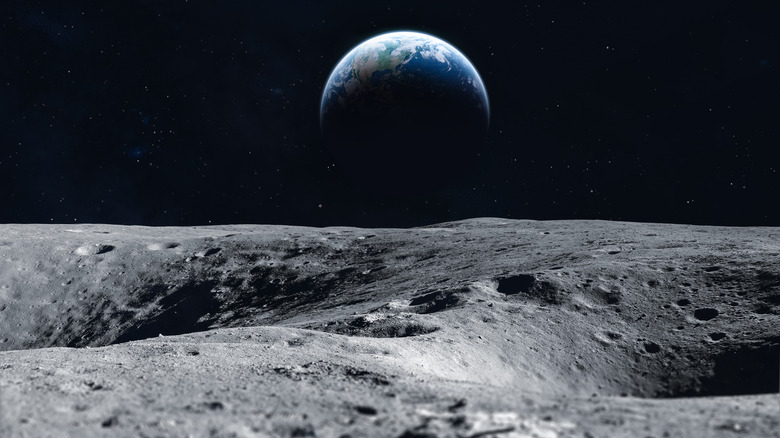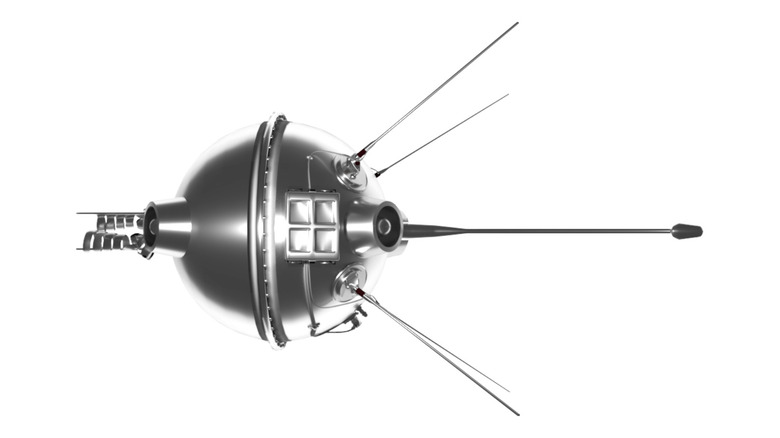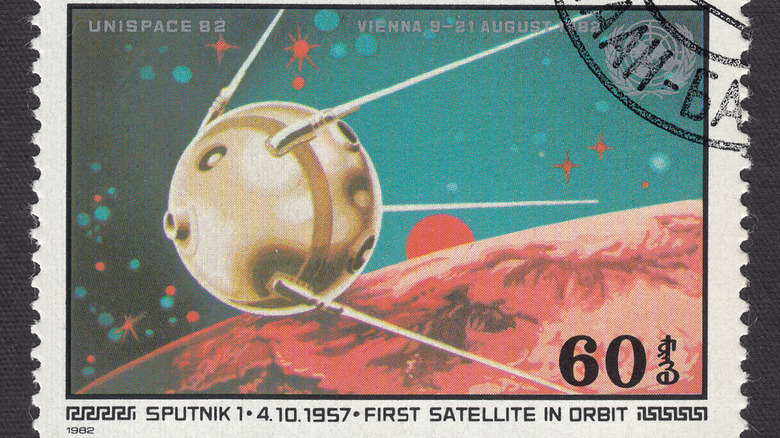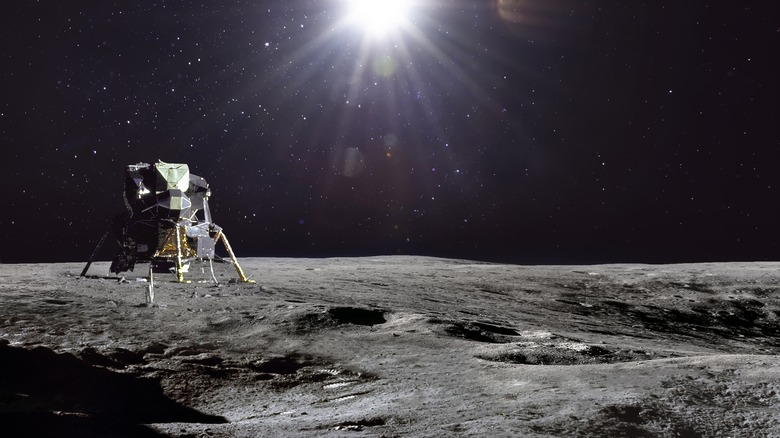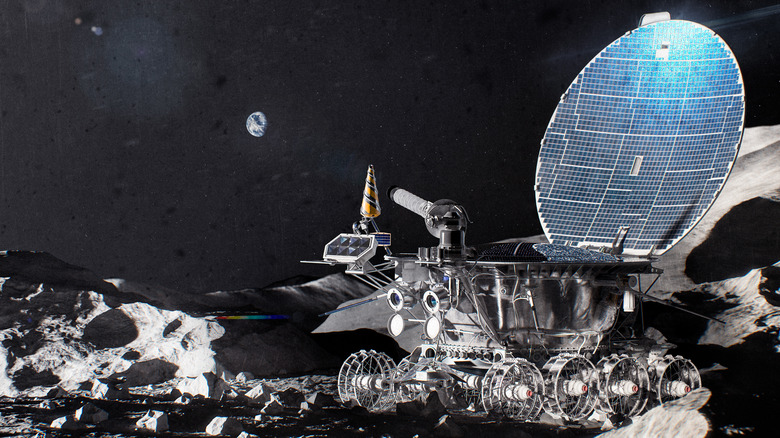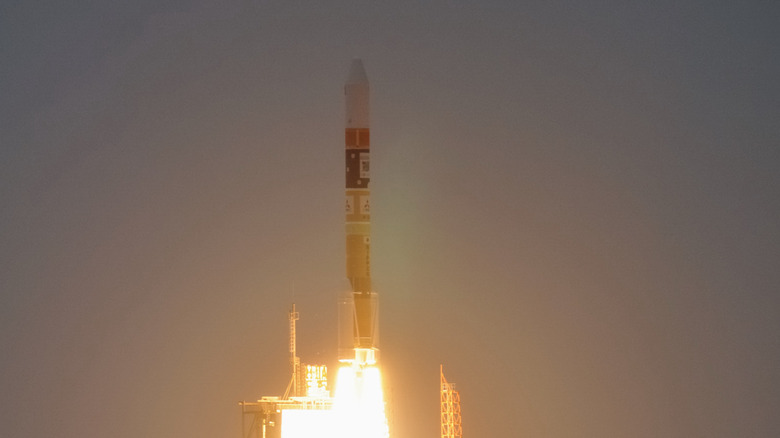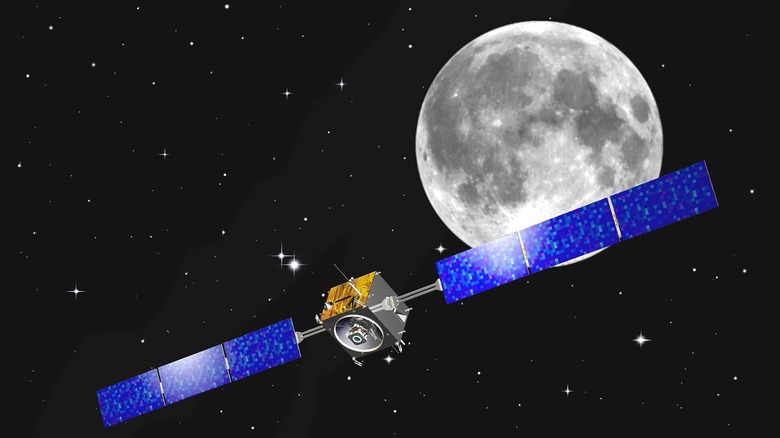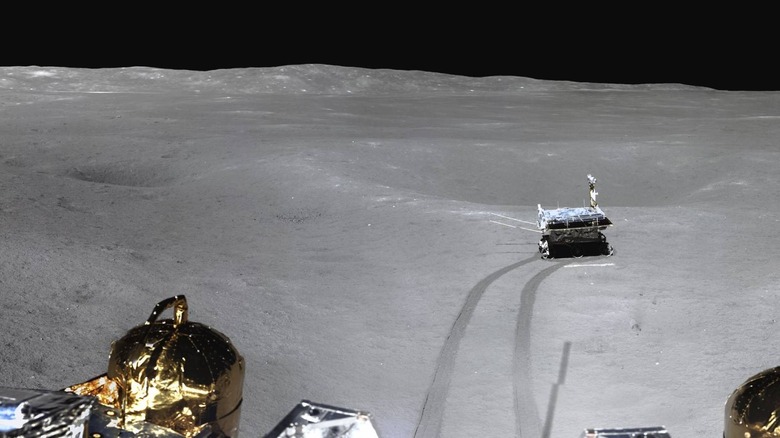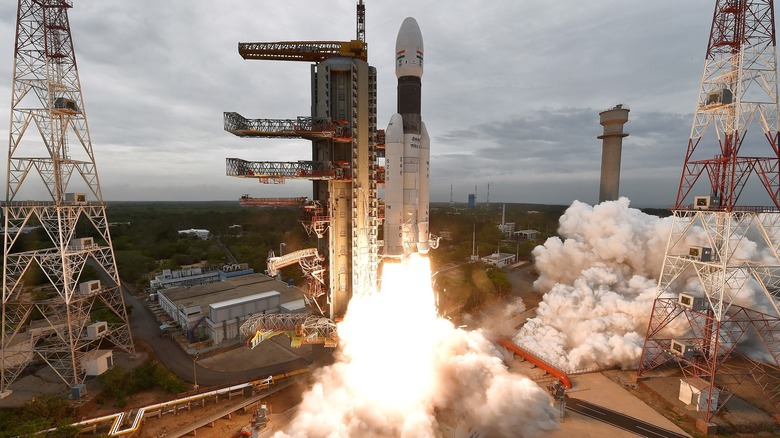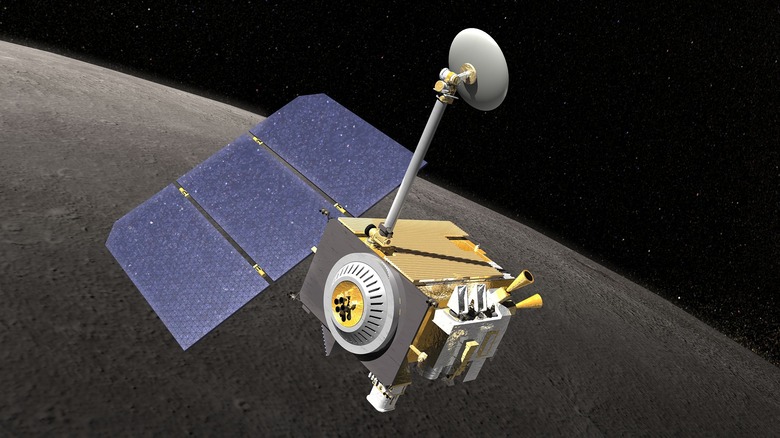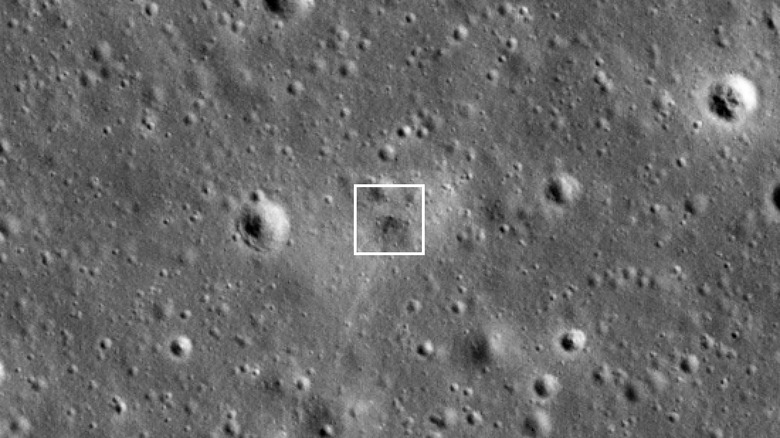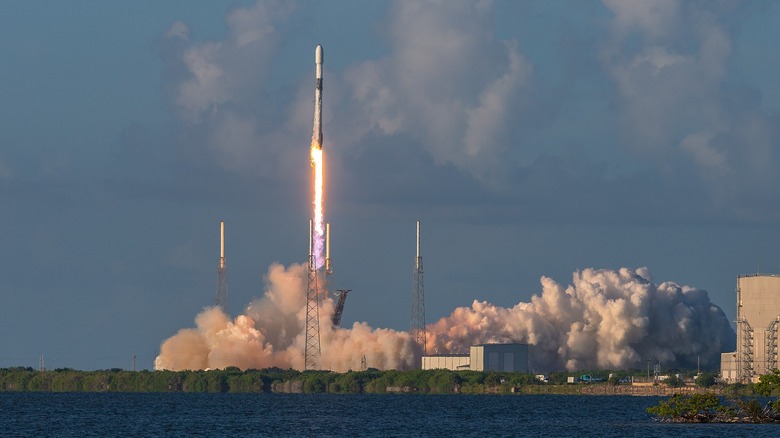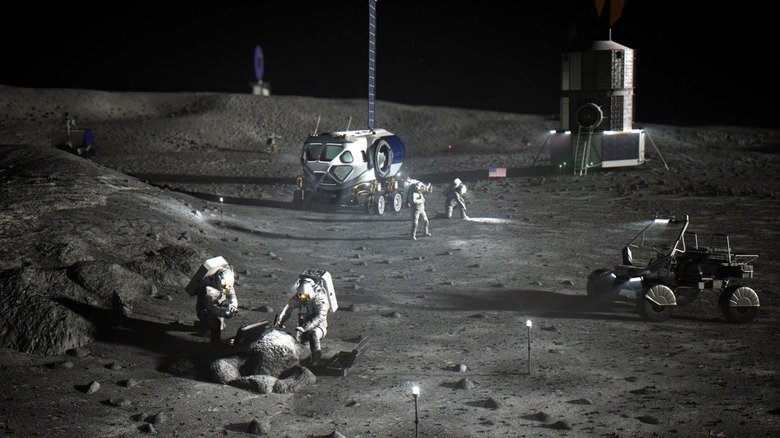The Entire History Of Lunar Exploration
For the first time since 1972, the Moon may soon see humans set foot on it once more. This time, we may even be taking up long-term residence there. That's the ultimate goal of NASA Artemis, a lunar exploration program following in the footsteps of the 20th century's famous Apollo astronauts. Artemis aims to make new scientific discoveries, fuel new industries, and inspire a new generation of people by showing them the wonders of space travel. Although the first two launches were canceled for safety reasons, NASA will try again at two later dates in 2022, according to The Verge. The plan is to send an uncrewed Orion spacecraft to the Moon and back as a dress rehearsal for sending vehicles later on that carry humans.
At the speed of a typical Boeing 747 (which travels at around 614 mph), it would take more than two weeks to reach the Moon, orbiting Earth at a distance of 238,855 miles away. This is no easy feat, but the Moon is still relatively close compared to other planetary bodies and people have sent numerous spacecraft there since the first 20th century attempts. As NASA notes, the earliest journey to the Moon was in 1959, well over half a century ago.
The first craft to reach the Moon
The earliest attempts to reach the Moon took place during the Cold War as part of the Space Race. As History.com explains, the U.S. and the USSR were locked in a bitter rivalry, trying to outdo one another and prove their technological superiority. Both superpowers took the kind of resources usually reserved for war and poured them into space travel, leading to decades of incredible feats of engineering and scientific accomplishments.
In 1959, NASA's first craft that flew past the Moon was Pioneer 4, an ancestor of the many interplanetary crafts that NASA would later launch. Pioneer 4 was never intended to stay at the Moon though. Instead, it was bound for a heliocentric orbit, with the goal of taking measurements of the Moon as it passed by. Unfortunately, it never made it close enough to do so, passing by the Moon at about twice as far as intended.
Pioneer 4 followed hot on the heels of the first craft to fly past the Moon: the Soviet Luna 1 craft. Although the Soviet Union's probe passed the Moon first, the Russian spacecraft didn't quite succeed in its mission either. It was supposed to touch the Moon's surface but missed by around 3,700 miles. Even a target as large as the Moon can evidently be hard to hit from such a great distance!
The Soviet Luna missions
The USSR's Luna program included a series of 24 robotic probes that made many of the first successful trips to the Moon. USRA notes that the Luna probes scored a number of firsts, including Luna 2 being the first craft to impact the Moon's surface and Luna 3 returning historic first images from the Moon's far side. They were fuzzy, black and white, and low-resolution, but it was a milestone nonetheless. This was a sight never before seen on Earth.
Luna 9 was the first vehicle to make a soft landing on the surface of the Moon (rather than crashing into it). The robotic probe became the first of many to send back photographs of the surface of something in outer space. In fact, Luna 9 was the first controlled landing anywhere outside of Earth, though it would be quickly followed by Venera 3 landing on planet Venus (via Wired). The Luna program is still remembered fondly enough that, as Space.com explains, Russia's space agency Roscosmos plans to revive the old program by launching Luna 25 in 2023.
The cancelled Soviet space program
The first astronauts to visit the Moon were not human. Instead, in 1968, the Soviet Zond 5 spacecraft carried a crew of tortoises on a trip around the Moon before landing safely back on Earth. According to Discover Magazine, the two steppe tortoises were proof that living things could survive the journey to the Moon and back (together with their fellow passengers — a few worms, insects, and seeds). Unfortunately, due to a combination of conflict within the agency, a lack of funding, and the tragic death of cosmonaut Vladimir Komarov, Soviet dreams of sending a crewed mission to the Moon were foiled.
The Zond spacecraft missions were intended to be the precursors to sending cosmonauts to the Moon, as explained by the Universidade Federal do Rio Grande do Sul. They were essentially stripped-down versions of the Soyuz spacecraft, which was first flown in 1967. "The Soviet Reach for the Moon," explains that the Zond crafts were intended to lead to a lunar lander mission which would effectively have been a Soviet version of the Apollo program. The vehicle that they planned to send was named Lunnyi Korabl (LK). Unfortunately, as Smithsonian Magazine explains, the LK would never make it off the ground. Instead, Russia's lunar program was plagued with disasters, including a rocket explosion that destroyed an entire launch pad. In the end, the first small steps on the Moon would be made by American boots.
The first footsteps on the Moon
The first vehicle to take humans to the Moon was the NASA spacecraft Apollo 8. Launching at the end of 1968, it would carry the first three people ever to leave Earth's orbit. This would also be the first time humans had ever been propelled into space by the towering Saturn V rocket. According to NASA, the crew was the first to orbit the Moon, see the far side with their own eyes, and witness an Earthrise. But the most impressive feat was yet to come.
In the 1969 moon landing mission, NASA launched Apollo 11 and completed the goal set 8 years earlier by President John F. Kennedy. In just a decade, NASA went from sending Pioneer 4 to the Moon to sending up a crew of people, including the first humans to ever set foot on the Moon, Neil Armstrong and Buzz Aldrin. Over the course of the six Apollo Missions to successfully land on the Moon and to date, only 12 people have ever set foot on the Moon. The work they did there, however, is still a testament to what humans are capable of. After all, we haven't been back to the Moon since.
Russia's Lunokhod rover
While the Soviet Union would never send a crew to the Moon, they did make one other important contribution to space exploration: developing the first ever mobile robotic explorers, the Lunokhod rovers. According to NASA, Lunokhod 1 was under (almost) real-time control by operators back on Earth, traveling to various locations on the lunar surface and running tests on the soil. It also sent back a host of TV images of the grey and dusty vistas all around. In 1970, Lunokhod 1 became the first rover to successfully land on the Moon, working tirelessly for 11 lunar days (which translates to about 11 months on Earth). In collaboration with French scientists, the robot explorers also refined the measurement of the distance from Earth to the Moon.
Its successor, Lunokhod 2, was even higher profile. Smithsonian Magazine explains how, in 1973, the robotic explorer transmitted 69,000 TV images back to Earth and produced 86 panoramas of the lunar surface to showcase the dramatic landscapes of the Moon. Unfortunately, a short circuit dramatically shortened Lunokhod 2's lifespan, giving it just four months of operating time on the Moon's surface. In the end, the USSR would only send these two Lunokhod rovers to the Moon's surface. However, as E&T Magazine notes, they have had a proud legacy in space travel as they were effectively the ancestors of all other space rovers, including the ones that NASA is working to send to Mars.
Japan reaches the Moon
After the Apollo and Luna programs ended in the 1970s, the world largely lost interest in traveling to the Moon, and attention was focused elsewhere for a couple of decades. Then, in 1990, Japan became the third country to visit the Moon. In a mission run by the Institute of Space and Astronautical Science (ISAS), the robotic spacecraft Hiten was sent on an experimental mission, becoming the first robotic vehicle to visit since the Soviet Luna 24 probe in 1976 (via USRA).
In 2003, ISAS would merge with two other Japanese agencies, forming JAXA. This new program would soon send a second Japanese spacecraft to the Moon in 2007. This space probe, KAGUYA, boasted a variety of scientific instruments. Its goal was to explore the Moon and develop technology for future Japanese lunar missions. But KAGUYA carried one other important thing: It was fitted with a high-definition (HD) camera to send back spectacular images from lunar orbit that showed both the rolling surface of the Moon and Earth above. With its camera, KAGUYA recorded the first ever images of an eclipse seen from the Moon, with the sun passing behind Earth (via Space.com). KAGUYA continued sending back HD video footage of the Moon until its mission ended in 2009. It's still some of the most impressive imagery of the Moon's surface ever recorded.
Budget flight to the Moon
The next organization to go to the Moon was the European Space Agency (ESA), which sent a machine called SMART-1. This spacecraft's main goal was largely related to testing new technologies. It was equipped with miniaturized instruments and an experimental solar-electric propulsion system. The result was a smaller, lighter, and more densely equipped spacecraft. Perhaps the most impressive thing about SMART-1, though, was the price tag. With a total budget of around $108 million (including launch and operations), it cost around one-fifth as much as most of ESA's other major science missions. With careful management, only four years of development, and a ride into orbit shared with two other crafts, the budget for SMART-1 was miniaturized — fitting for a spacecraft just one cubic meter in size.
The ESA plans to work with NASA in the near future. As the latter explains, ESA is working on the Lunar Pathfinder satellite, which will help future spacecraft navigation. This will ultimately inform NASA's upcoming Artemis launch, acting a bit like a lunar GPS to help future spacecraft missions. The ESA is also developing the European Large Logistics Lander (EL3) to carry payloads to the Moon's surface.
China's ambitious Chang'e program
One of the most impressive series of spacecraft missions to the Moon in the 21st century is the Chang'e program, run by the China National Space Administration (CNSA). According to NASA, Chang'e 1 (named after a Chinese moon goddess) was the first ever Chinese deep space mission. Launched in 2007, it made a detailed map of the Moon and paved the way for the rest of the Chinese lunar program. One of its biggest successes has been Chang'e 4 which was the first spacecraft to land on the far side of the Moon, per National Geographic. Complete with a lunar rover, its work on the Moon was still ongoing as of October 2021, when the mission hit the 1000-day milestone (via Space.com). The Yutu 2 rover carried by the Chang'e 4 spacecraft may only have traveled less than a mile from its landing site, but it has gathered over 3,600 gigabytes of data since the onset of operation.
According to New Scientist, CNSA's most recent moon vehicle is Chang'e 5, which successfully returned a sample of lunar rock to Earth. As the Planetary Society explains, this is the first time any spacecraft returned Moon rocks to Earth since the Soviet Luna 24 craft in 1976. In addition to the rock collection, Chang'e 5's goals include using radar to peer beneath the surface of the Moon and analyzing the soil for traces of water.
India's Chandrayaan discovers water on the Moon
The question of whether or not water exists on the Moon was answered by the Indian Space Research Organisation (ISRO). As the Planetary Society notes, it was ISRO's Chandrayaan-1 craft that found the first traces of water there in 2008. Working with NASA, Chandrayaan-1 carried an instrument called the Moon Mineralogical Mapper (or M3 for short), which found the first hints that the deep craters of the Moon aren't quite as dry as scientists originally thought.
Following the success of Chandrayaan-1, ISRO built and launched the Chandrayaan-2 probe in 2019, according to NASA. This time, the plan was to send a landing craft, called Vikram, to touch down on the Moon's surface. Unfortunately, Vikram crash landed, and NASA later reported finding its crash site on the Moon's surface. Despite the lander's failure, the Chandrayaan-2 orbiter is still operational and continues to send back data and images from the Moon's surface, per ISRO. The lunar orbit is seemingly becoming a busy place. In 2021, Chandrayaan-2 had to dodge one of NASA's ongoing lunar missions, the Lunar Reconnaissance Orbiter (LRO).
NASA plans a return journey
In 2009, NASA launched the Lunar Reconnaissance Orbiter (LRO) with the goal of making a detailed map of the Moon's surface. It's been orbiting the Moon and gathering data ever since. As well as looking for interesting locations on the Moon's surface, LRO is also responsible for seeking out good terrain for potential future landing sites, including places to send crewed landers. In 2010, LRO finished its exploration objectives and was taken over by Science Mission Directorate. Since then, LRO has been serving as an observatory of the lunar surface.
Around the same time LRO was sent to the Moon, NASA also launched the Lunar Crater Observation and Sensing Satellite (LCROSS). With the specific goal of peering into lunar craters, LCROSS confirmed Chandrayaan-1's earlier observation that there is water on the Moon. In fact, not only is there water, but the Moon is more chemically active than scientists once thought. It was discovered that with the ice crystals gathered in its deep craters, the Moon even has its own water cycle.
Taxi ride to the Moon
The 21st century has also seen the rise of privately funded space travel. Where travel to the Moon was once the sole reserve of government agencies, private companies are becoming increasingly important in lunar exploration, and the first company to make its mark was LuxSpace. A Luxembourg-based company, LuxSpace built the Manfred Memorial Moon Mission (nicknamed 4M). Space.com explains that 4M was essentially a hitchhiker, catching a ride to outer space on a Chinese rocket in 2014. 4M had intended to be only a flyby mission but, after years in space, it accidentally crashed into the Moon. As RTL reports, it was traveling at a blistering speed of over 5,500 miles per hour and was projected to leave a lunar crater more than 60 feet wide.
The second private company to attempt a trip to the Moon was an Israeli company, SpaceIL. As NASA notes, they launched a spacecraft called Beresheet in a Falcon 9 rocket hired from SpaceX in 2019. Beresheet had intended to land on the Moon's surface, but the craft lost contact shortly before it was due to touch down. Arizona State University shows how its crash site was later discovered by LRO. Despite its failure, Beresheet was a milestone in travel to the Moon, being the first vehicle ever to be developed and launched entirely by private companies.
Korea's first lunar mission
In August 2022, the Korea Aerospace Research Institute (KARI) became the seventh country to launch a spacecraft to the Moon. Officially called the Korea Pathfinder Lunar Orbiter, Nature notes it also goes by the name of Danuri. Launched on a different trajectory to previous Moon missions, Danuri will take longer to reach the Moon, but the different journey means it will use far less fuel to reach its destination. Korea Times reports on Danuri's successful launch, noting that it was put into orbit by a SpaceX Falcon 9 rocket (again showing how private space travel's influence is helping to make space travel accessible).
Danuri is currently en route to the Moon, but KARI already has plans to become more involved in space exploration. Danuri is just the first step towards a planned lunar landing mission currently intended to make it to the Moon's surface before 2030. Evidently, South Koreans are deeply invested in the idea, with a survey finding that 72% of the population favors pursuing lunar exploration. With Korean astronauts already famous for bringing kimchee to the International Space Station, perhaps some future lunar visitors might get to enjoy Korean cuisine while they're there.
Artemis and the future
To test orbits for future space travelers, NASA launched the CAPSTONE satellite in June 2022. The data it gathers will be used by NASA Artemis with the goal of taking people back to the Moon sometime soon. While NASA still holds the accolade of being the only agency to send people to the Moon, there's currently a flurry of interest from other countries too.
As Nature explains, several more countries are planning to send spacecraft to the Moon sometime in the near future, including Japan, South Korea, Russia, India, and the United Arab Emirates. Several have the long-term goal of sending astronauts there. NASA's vision for the mission is outlined in the Artemis Accords, which state that the goal is to benefit all of humanity in terms of both exploration and commercial activity. (Another goal is to land the first woman and first person of color on the Moon.)
However, while a few countries have already committed to participating in the Artemis program, Russia and China are pursuing their own space programs independently. Could the 21st century see another space race taking place? Perhaps only time will tell.
